UX researchers utilize many research techniques and product development frameworks to understand their users. Of all of the methodologies I’ve tried, Jobs-to-be-Done (JTBD) is my favorite. It’s a theory that helps UX professionals uncover true customer needs and keeps teams focused on solving the right problems.
In this article, I’ll give a brief overview of the JTBD framework and provide an example of an interview I’ve incorporated into my UX research process as Head of Design at two fintech companies to give you a better idea of how you can apply the framework yourself.
What is Jobs-to-be-Done?
The core theory of JTBD is that customers don’t buy products or services; they hire them to complete a job they need done. JTBD looks for the cause behind a customer’s decision to hire a product, which can often be different from what the company thinks. Understanding these causes makes product innovation easier and more likely to succeed.
JTBD are different from personas, a commonly used UX method. While both aim to create deep empathy for the user’s needs and goals, personas focus on demographic and psychographic data to create an aggregate view of the target customer, while Customer Jobs focuses on analyzing customers’ actual buying behavior and the reasons behind it. It’s a difference in correlation vs. causation.
JTBD has been developed and practiced by various individuals over the past three decades. Although different perspectives exist on the basic tenets of the framework (sometimes practitioners disagree over these tenets), I favor the work of Clayton Christensen of Harvard Business School and Bob Moesta of the Re-Wired Group as outlined in their books Competing Against Luck and Demand-Side Sales respectively.
For an excellent overview of the Jobs-to-be-Done theory, I’d recommend LogRocket’s overview of JTBD.
Understanding Job context
JTBD identifies the struggling moment in a customer’s life to understand the right solution for their needs in a given set of circumstances. For example, I’m currently buying a desk for my home office. Desk manufacturers may want to market their amazing features to me like sturdiness, materials, dimensions, and price. But these aren’t the reasons I’m buying in this case.
I’m looking for an attractive, foldable desk that I can use to invite friends, who are also remote workers, over for the day. The desk’s JTBD in this case is to “help me keep in contact with other local designers” and “make working from home less isolating and more creative.”
In this context, I value features like the ability to fold and store the desk and a relatively low price. If instead I were replacing my everyday WFH desk, I would prioritize an entirely different feature set: sit/stand, aesthetic, strength, etc.
Jobs are context-dependent, so it’s important to understand the users’ circumstances in order to innovate the right solution.
How to uncover Jobs-to-be-Done: The JTBD Switch Interview
The best way to uncover the customer’s Job to Be Done is to talk to them. It sounds simple but you’d be surprised how many companies don’t do this. The JTBD Switch Interview is a research method to uncover the customers’ Job at the moment they hired — that is, adopted or switched to — your product. Don’t wait too long or their memory may be fuzzy on their true decision criteria.
Once you’ve scheduled an interview with a new user, you’ll ask them to recount their buying story. You’re listening for their struggling moment (their JTBD) by identifying four forces that acted on their hiring decision. You’ll also be constructing a timeline of events that ultimately led them to hire your product or service. This video from the HBS includes an overview and tips for conducting the interview. You can also see a few example interviews on consumers purchasing a new car or a Peloton bike.
For the interview itself, I prepare a note-taking worksheet like the one shown below. The lower section is for documenting the timeline events and the upper section is divided into quadrants for the four forces of progress.

The top two forces promote forward progress and encourage a change in how the Customer Job is fulfilled:
- Pushes are all the irks, annoyances, and external pressures related to the status quo. Pushes cause the user to seek a new solution to their Job
- Pulls are the allure of something new. Pulls motivate a user to change by creating an image in her mind of a better version of herself
The bottom two forces resist change and encourage sticking with the status quo. If these forces outweigh the top two forces, the customer will stick with their current solution for completing their Job:
- Habits (also called inertia in JTBD) are the things the user is accustomed to with the status quo. It’s often easier to do nothing, even if a new solution seems more appealing
- Anxieties are reasons to doubt the new solution can help the user get their Job done. This category includes hesitations or uncertainty that arise from not wanting to make a change
An example JTBD interview
As a demonstration for this article, I reached out to my network to interview someone who had recently made a large purchase. I spoke with a woman I’ll call Brittany, who recently bought a condo with her husband in Utah. I’ll walk you through this interview as if I was the UX researcher for the condo developer to illustrate what to look for in uncovering a customer Job to Be Done. (Coincidently, Bob Moesta famously performed JTBD for an actual condo developer. Read more in his book Demand-Side Sales.)
To start the interview, I begin with some preliminary questions or banter to get Brittany comfortable talking with me. I then transition to asking Brittany to recount her purchasing journey, starting from what she bought and when. I found out that the couple’s journey took about six months and started when their apartment rent suddenly increased dramatically, leading them to move in with Brittany’s in-laws.
The increase in rent was a key trigger that set off the chain of events that ultimately resulted in the condo purchase.
N.B., as you interview, look for these important triggers to illuminate your buyers’ behavior. Over the course of many interviews, listen for patterns.

Here’s a look at the timeline of events from my interview notes. These are “the dominos that had to fall” in order for the condo purchase to happen.
N.B., while I note events that happen after the purchase, like issues that arose with radon gas, mold, and their HOA, these are not part of the hiring criteria Brittany used when selecting the condo to fulfill her Job-to-be-Done. You should ignore these events when considering why your product was hired.

The interview with Brittany was fascinating because it contained a failed switch and a successful one. Prior to closing on the Utah condo, Brittany and her husband had put in an offer on a Wisconsin farm but had pulled out before the transaction completed. This was puzzling to me at first because the farm seemingly had everything the couple was looking for — much more than the condo did. So why did the second close when the first did not?
Let’s take a closer look at the forces at play.
When habits and anxieties outweigh pushes and pulls
Below is the filled-in JTBD worksheet for the attempted switch between living with the in-laws and purchasing a farmhouse in Wisconsin. Brittany described the farmhouse as their “dream home.” She described how they “love being outside, with animals, and being part of the land.” If you examine the pulls — Brittany’s vision for a better version of herself — the farmhouse was checking all the boxes.
There were also plenty of push forces, the struggling moments of the situation that made Brittany ready for a switch. Both she and her husband were remote workers who could live anywhere they wanted. In 2022’s environment of rising interest rates and low real-estate inventory, Brittany felt the pressure and a sense of urgency to move quickly on a decision.
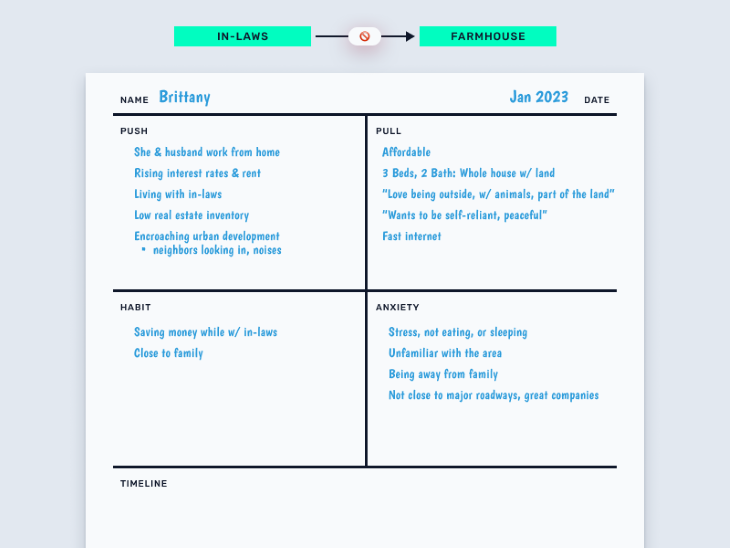
With so many forward forces, why wasn’t a switch made?
As strong as the top two forward quadrant forces were, they could not overcome the strength of the habits and anxieties to break the status quo. The thought of moving out of state and away from extended family, particularly while the couple was planning to start their own family, created lots of stress and sleepless nights. That anxiety eventually took over, and Brittany withdrew her offer on the farmhouse.
In product design we often think about all the ways we can make our products more attractive to potential customers; we think about the features and benefits we can add. However, we often overlook the friction and the switching costs that prevent somebody from adopting us. If the friction is too great, customers will not adopt or engage with our product, no matter how well it meets their Job to Be Done.
The other takeaway from this interview is the reminder that not all Jobs are functional. Functionally, the farmhouse met all Brittany’s needs for indoor/outdoor space, remote-friendliness, and affordability. However, Jobs can also be social and emotional. The social habit of living close to family and the emotional connection that proximity provided are strong counterforces that a large piece of land in another state could not overcome.
When pushes and pulls outweigh habits and anxieties
One month after withdrawing from the farmhouse deal, Brittany and her husband purchased a condo. I’ve updated the JTBD worksheet below to reflect how the four forces changed from the farmhouse situation. On paper, the condo lacks most of the pull forces that attracted the couple to the farmhouse, such as privacy and a large piece of land. However, the condo moved one massive boulder from the habit quadrant to the pull quadrant: the proximity to family.
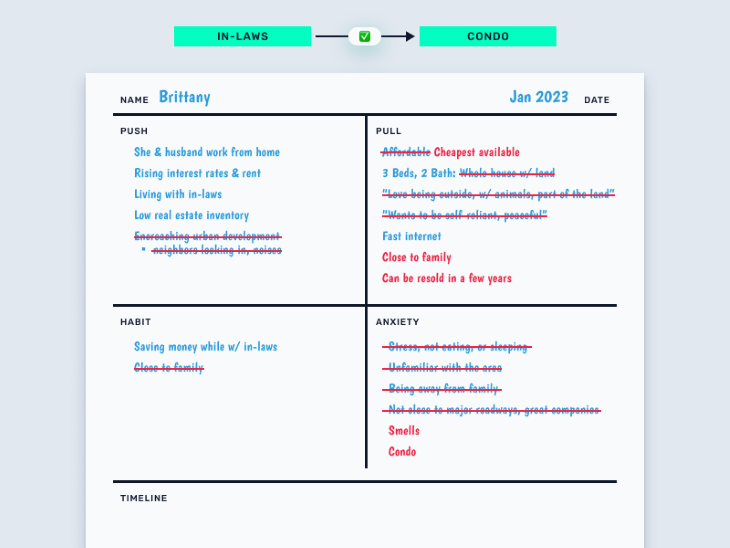
In my conversation with Brittany, it was clear they regretted losing the farmhouse. They blamed the stress of the situation for clouding their judgment and forcing them into a compromise solution, but a closer examination of the forces highlights that the true dealbreaker was moving away from loved ones.
The perception of a ticking clock from the push forces also created a strong urge for a quick decision with trade-offs. The couple chose to view the condo as a temporary solution, not their long-term home.
Applying Jobs thinking to UX
After conducting 7–10 Jobs interviews with recent adopters, you can form a concise statement, known as a Job Story, to articulate the most common job your product solves. In Brittany’s case, the Job could be summarized as:
“In a rising interest rate environment, I want to find a temporary place for my future family that is close to extended family and can be resold when market conditions improve.”
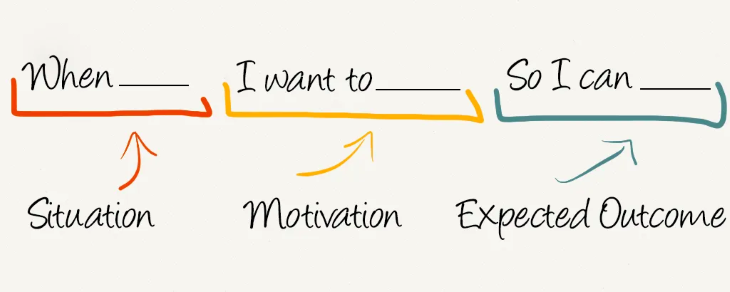
JTBD interviews can be a valuable tool in your UX research arsenal for understanding user needs and uncovering the benefits they value most. Sharing these insights with product management and company leadership can guide roadmap prioritization towards initiatives that create the most demand for your product or service, and help you design a solution that addresses your customers’ true Job-to-be-Done.
Header image source: IconScout
LogRocket: Analytics that give you UX insights without the need for interviews
LogRocket lets you replay users’ product experiences to visualize struggle, see issues affecting adoption, and combine qualitative and quantitative data so you can create amazing digital experiences.
See how design choices, interactions, and issues affect your users — try LogRocket today.
Source link

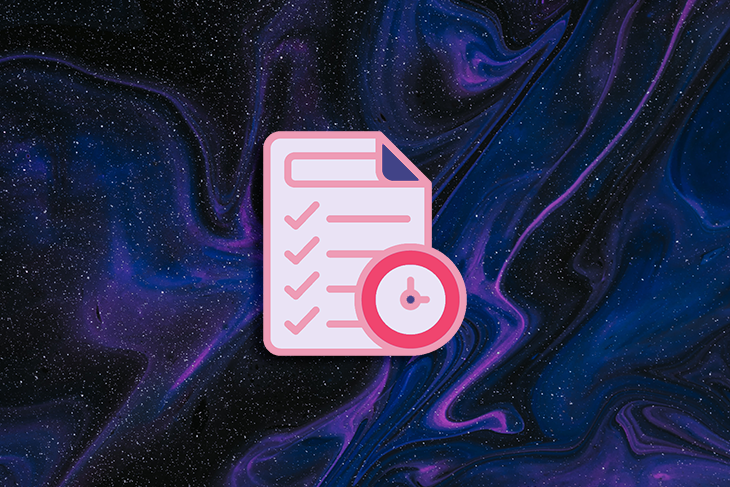
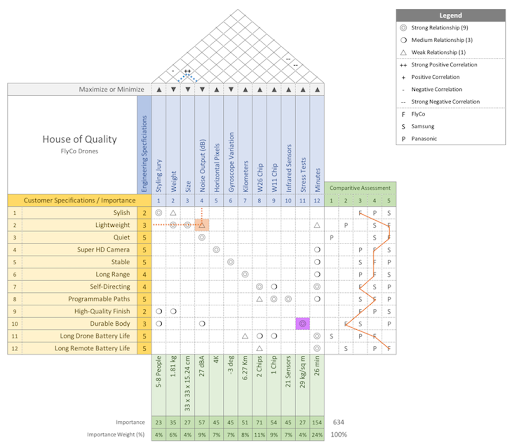


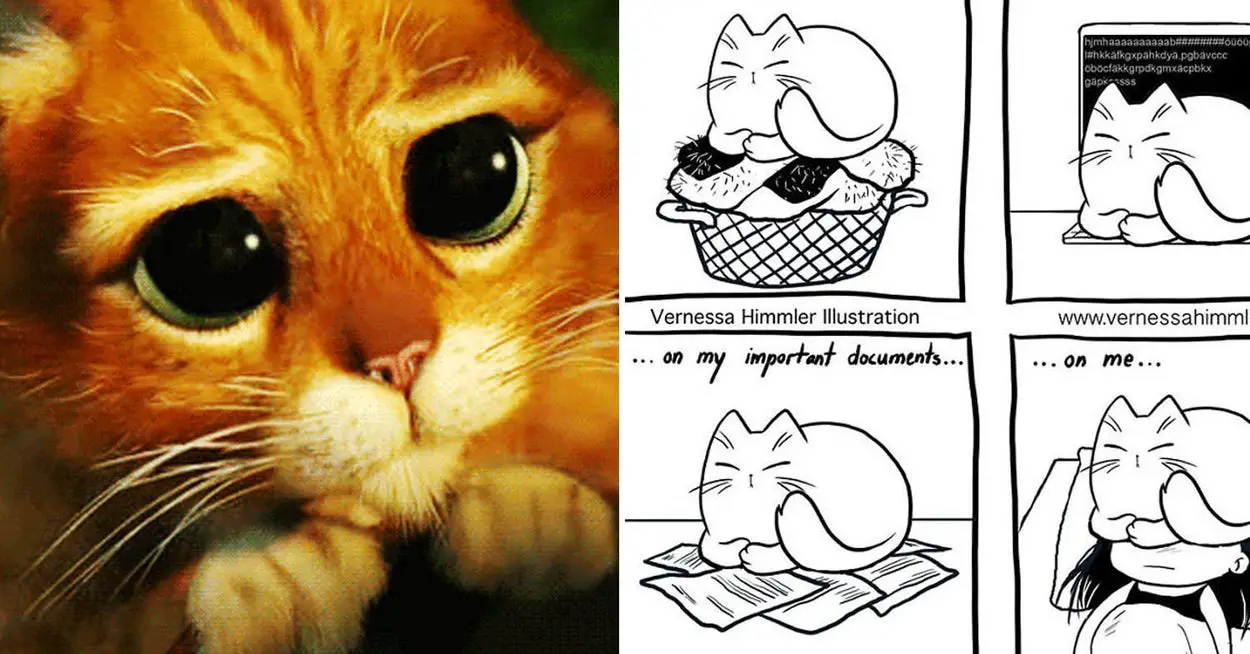


Leave a Reply